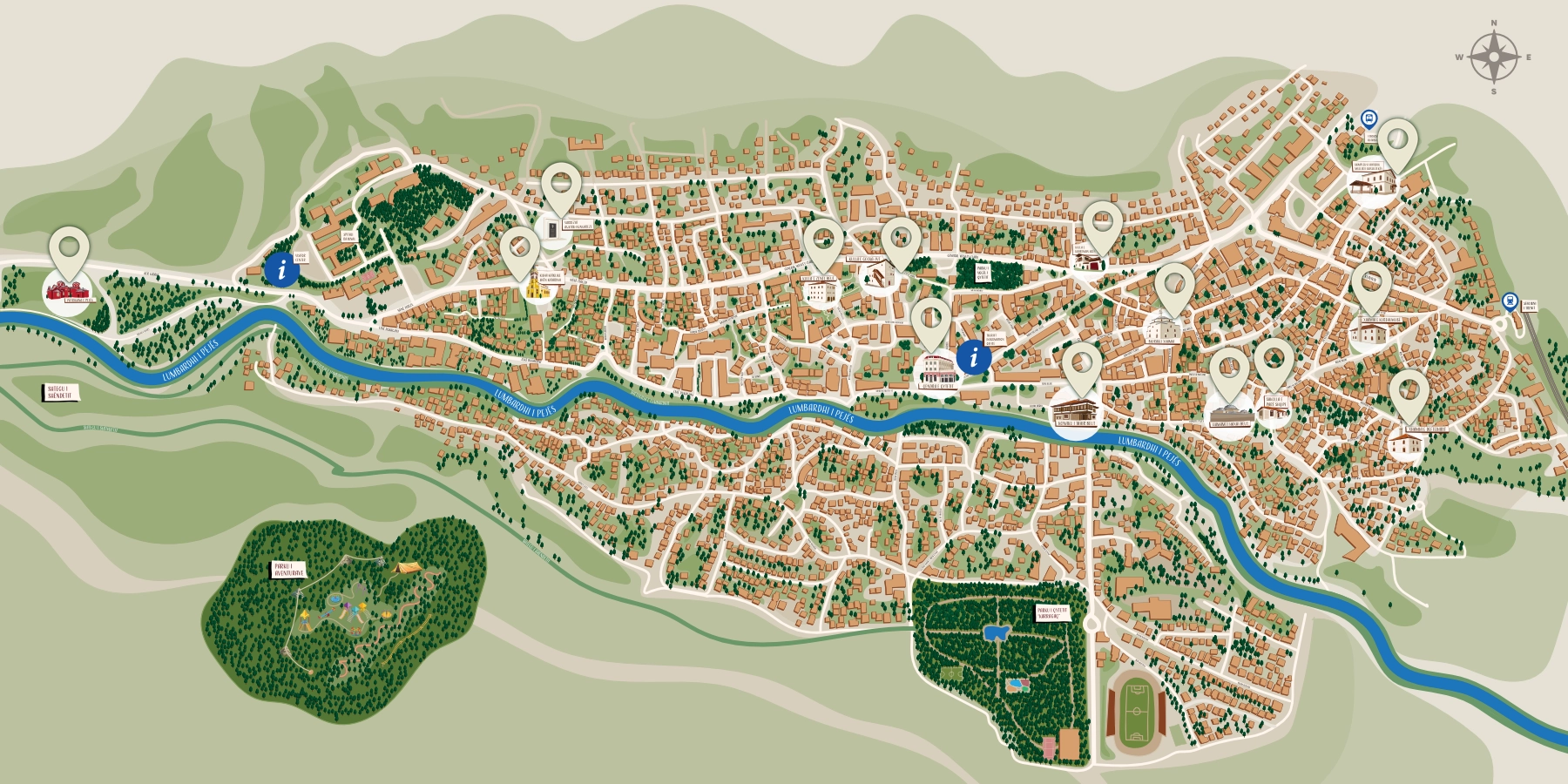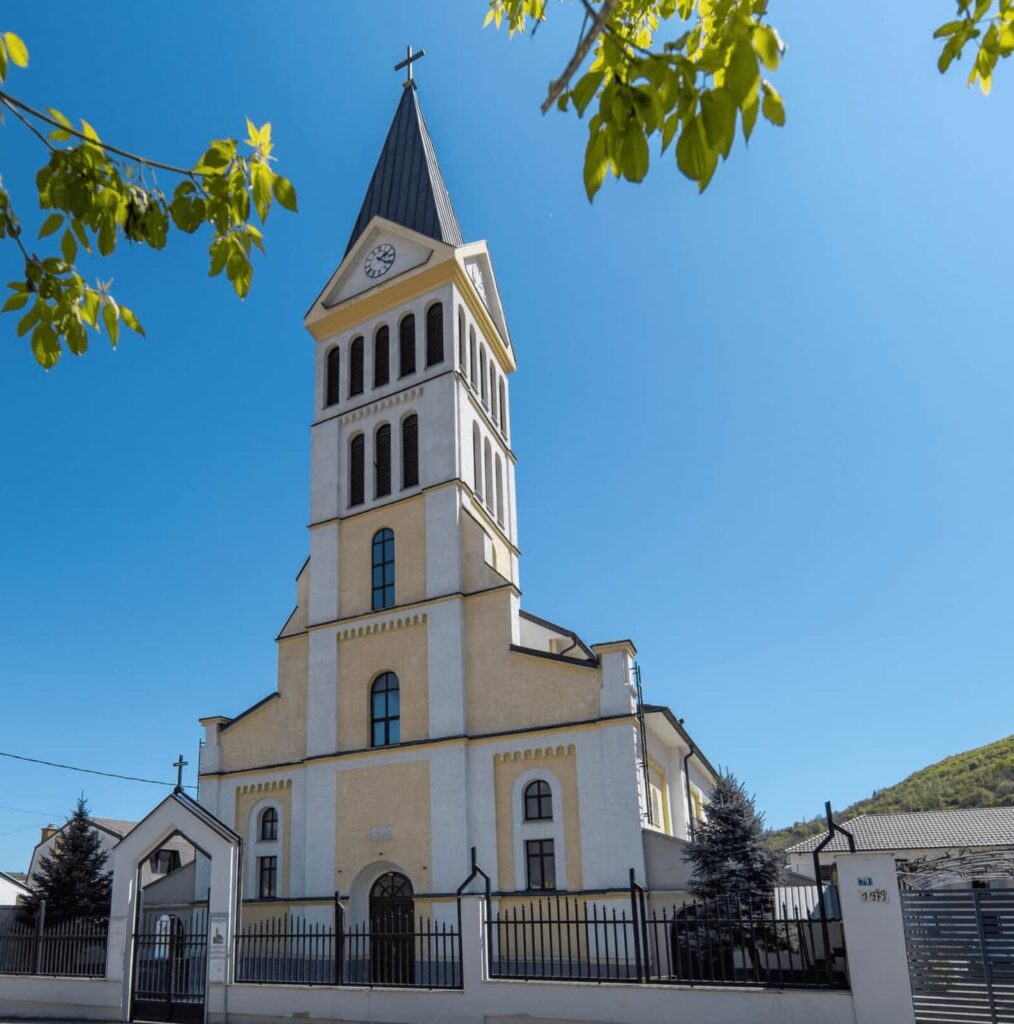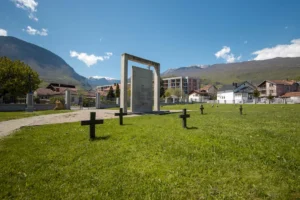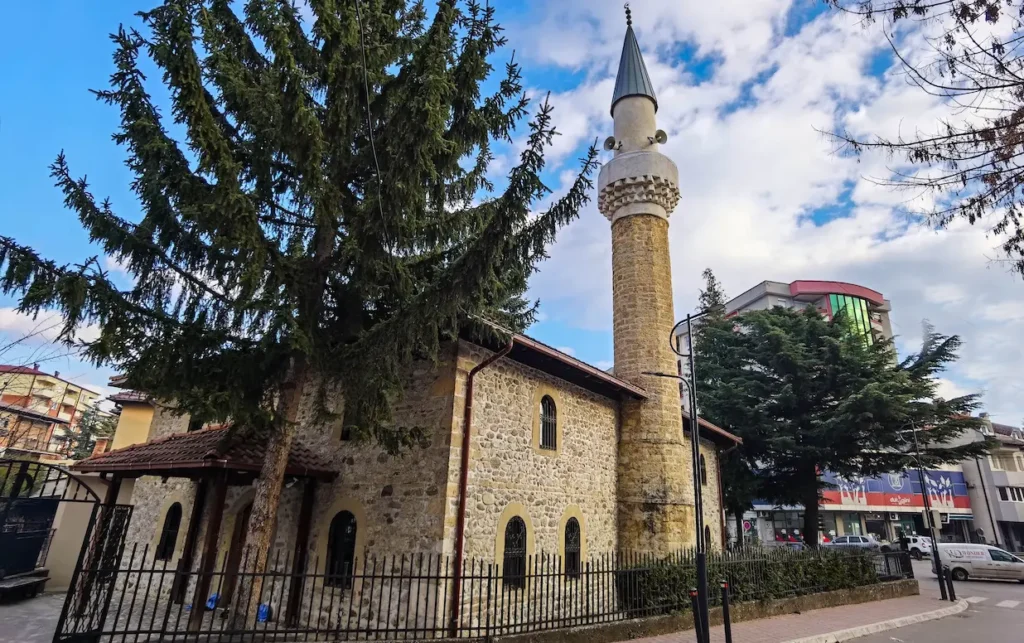Cultural Trail maps
Peja – known also as “The Flower of Dukagjin” or “The City of Haxhi Zeka“, ranks among the big cities in Kosovo, but compared to the cities of Europe it is relatively small but very lovely city and with easy movement for all ages. It is unique city because of the panorama view given by the crown of the mountain ranges of Peja while the River Lumbardhi that passes through the city brings the fresh air from the Rugova Gorge where residents spend their free time walking on the riverside promenade.
Peja is now a very attractive destination for visitors. Its geographical position, natural and cultural wealth, fertile lands and rural development, the active life of the community, sports as well as the traditions and artistic culture of the community make Peja to be unique in the region and to be visited by tourists all year round. The history shows that Peja has a very early development. Archaeological facts show that the early ancient settlement was located in the part of the Peja plain known as “Gradina”. Archaeological finds show that this ancient settlement was created on the foundations of an earlier Dardanian locality. Peja, which in ancient times was known as Siparantum of Dardania, during the middle Ages and other centuries we also encounter names such as Pentza, Peka, Pech and Forno.
So all this shows that Peja was a very well organized settlement and here an organized life developed at a higher economic and social level. Peja also has a history of development in different periods and almost every period has left its traces where visitors can experience all the history, cultures and traditions as if they were in different times. In history, Peja is also known among the cities that have played an important role at the national level. This city is also known as the city of Haxhi Zeka, who was a patriot and activist of the Albanian national issue. Haxhi Zeka is known as the founder of the League of Peja after the dissolution of the League of Prizren. Seeing this movement as quite dangerous, the occupier eliminated it by executing it in 1902. You can find all this history presented on the cultural tourist trail in the city of Peja in different ways as historical objects, presentations in the museum of Peja, in the daily life of citizens or even through photographs.

Patriarchate of Peja
______________________________________________
The Patriarchate complex includes four structures built at different times, all reflecting the Byzantine-Romanesque culture that flourishe d in the Balkans between the 12th and 17th centuries,characterized by a unique style of fresco painting. According to historical records, these structures were built upon the foundations of three smaller Catholic-Romanesque churches. This cultural heritage site, permanently protected by the state, is also part of UNESCO's heritage list.
St. Catherine Church

Austro-Hungarian Cemetery

A unique heritage site now transformed into a memorial is the Austro-Hungarian Cemetery, dating from 1915-1917. Most of the 168 soldiers who are buried here served under the Austro-Hungarian Empire, with 73 identified as from the Kingdom of Hungary and the Kingdom of CroatiaSlavonia, 49 from the Kingdom of Bohemia, Bukovina, Dalmatia, Galicia, Moravia, Silesia, Styria, Bosnia, and Herzegovina, and 46 whose origins remain unknown. Restored in 2014, the cemetery serves as a tourist site detailing a part of Peja's history.
Zenel Bey's Tower

Zenel Bey's Tower of is an asset of the architectural cultural heritage under protection. Known as the Bey's Residence, built in 1854, namely the last decade of the 19th century. Since it was a fortified residence, in addition to its true value as a residential building, the three-story tower also had a defensive character. As a compositional scheme, the construction belongs to the traditional towers (kulla) of the Dukagjini Plain, with elements of the neoclassical style. The tower was mainly used for housing, but in different periods of time there were also short-term changes in its purpose.
From 1854 to 1912 it was used as a Residence. After 1912 it was used for housing by the Zenel Bey family. During the years 1945-1947 it was confiscated by the communist government and used as a post office, but also as a prison. Later, the tower was returned to the descendants of Zenel Bey, who used it for housing until 1999. The same year, during the war in Kosovo, the tower was burned by Serbian forces. After the war, it was restored by the owner, who, in addition to housing, also uses the monument for business.
Gockaj's Tower

Goskaj's Tower is an asset of the architectural cultural heritage under protection. Built in 1884. This three-story tower, known as the tower of Shaban Gocka, distinguished by its authe ntic stylistic-constructional and architectural-functional and substantive features. It is a living testimony of the life and social organization of the 19th century, in the Peja region, reflecting the lifestyle of the rich and powerful families of the time. This construction belongs to the type of seven towers with an angular dormer extending from the right side of the front side. Within the framework of the architectural structure, the angular dormer slightly protruding from the contour plan in the form of an oriel appears as the main architectural-compositional motif. The tower mainly preserves the original state of the building, except for the transformation of the openings (windows) of the highest floor, which during the time of the Young Turks were covered with lintels. The monument was restored during the years 2000/2001 by the Swedish organization SIDA. Since 2002 the tower has changed its function and serves the administrative needs of the Institute for the Protection of Monuments in Peja, which was later named the Regional Center for Cultural Heritage in Peja
Peja City Center

Pleased with the information, we began our journey to explore the sites and experiences Peja had to offer. Our journey started by visiting the city's cultural trail, which includes 14 key points of historical and cultural significance in Peja. The tour began in the heart of Peja, where, besides the panoramic views and the natural attraction of the Lumbardhi River, they noticed two iconic hotels that symbolize Peja's identity and tourism development. The Korzo Hotel, built in 1928, was a contemporary hotel that adhered to the highest standards of the time, while the Dukagjini Hotel, constructed in 1956, was the most prestigious hotel in Kosovo and part of a chain of luxury hotels in former Yugoslavia. During that era, Peja served as a stopover for travelers moving through Europe.
In addition to these landmarks, they learned about key historical events and figures associated with Peja, including the statue of Mother Teresa, the memorial of the 1968 demonstrations, the memorial of the fallen soldiers, and statues of the general Shkelzen Haradinaj, who died during the war in 1999 fighting for the liberation of Kosovo.
Tahir Bey Inn

Tahir Bey's Inn is an asset of the cultural and architectural heritage under protection. Built in 1800, this monument was in the city center until 1960, but then it was relocated to "Haxhi Zeka" Square, to be later designated as the Ethnographic Museum. This old house, in its architectural and functional composition of the spatial-compositional structure, coincides with the features of many medieval houses of Peja. The base scheme of the guest house is of the "G" type, whereas the building structure is made of wood, stone and mortar. It is assessed as an asset of architectural, historical, material and spiritual importance. Therefore, with its age and originality preserved to this day, it represents a testimony of the cultural and architectural developments during the 18th century in the city of Peja. After the war, the building was conserved and restored several times by the Municipality of Peja, the Ministry of Culture, Youth and Sports, as well as by local and international organizations. The mansion has been under legal protection since 1955 and is currently designated as an ethnological museum.
Kahraman Aga

The cultural journey continued with visits to four Towers Kulla - traditional fortified stone houses from Peja and the Dukagjin Plain. The kullas represent an essential part of Peja's heritage, dating from the 18th to 20th centuries. These fortified homes, built with two or three floors, often feature detailed exterior decorations and reflect the craftsmanship of Albanian stone masons. Each floor served a specific function: the first floor as a stable, the second as family living quarters, and the third as a men's gathering room. Peja was once rich in these kullas, each with unique architectural features, but many have been destroyed over time due to various reasons, including occupations and lifestyle changes. The cultural trail includes visits to the most interesting kullas, such as Haxhi Zeka's, Kahreman Aga's , Gockaj's (open for visits), and Zenel Bey's, the oldest kulla in the city.
Bajrakli Mosque

Bajrakli Mosque is an asset of the architectural cultural heritage under protection. It was built in the second half of the 15th century, namely in 1471 on the core of the old bazaar in Peja. Its donor was Mehmet Fatihu who also financed the Great Mosque in Prishtina. This mosque is one of the most important sacral architectural buildings of the Ottoman period and as such represents a testament to the cultural and architectural developments during the 15th century in the city of Peja.
As a classical monumental building with a complete compositional scheme, it possesses high aesthetic values that include combined volumes on the exterior, qualitative construction techniques and original decorative elements preserved both on the exterior and in its interior. It is also distinguished as the mosque with the highest dome (cupola) in Peja. Within it is a complex of tombs, most of which have inscriptions. Among them are those from the 16th, 17th, 18th and 19th centuries. Within these tombs on the right side are also the tombs of well-known personalities of the nation, such as the tomb of Haxhi Zeka, that of Ali Pasha Gucia, and the tomb of Haxhi Mustafa Bey. The tombs also have decorative moles. Despite being under protection, during the last war in Kosovo in 1999 the monument was burned by Serbian forces. But after the war, thanks to the Italian organization "Intersos" and the Italian Ministry of Foreign Affairs, in 2002 the mosque was restored, preserving its originality almost entirely. There was also a conservation and restoration intervention by the Turkish Tika in 2018. It continues to be in the function of citizens of the Islamic faith who practice spiritual and religious rituals.
Haxhi Zeka's Mill Complex

The economic history of Peja is closely tied to the construction and operation of the Haxhi Zeka Mill, a key project that marked the beginning of an industrialization period for the city and the broader region. This mill, which served not only the residents of Peja but also those from surrounding areas like Rozhaje, Plav, and Gusinje, became a strategic hub for trade and rural development. Its significance extended beyond economic benefits, as it also carried a national dimension due to the involvement of Haxhi Zeka, a well-known patriot and activist of the Albanian National Movement. As the founder of the “Peja League”, Haxhi Zeka remains a central figure in the history of Albanian resistance and political organization in the late 19th century. The Haxhi Zeka Mill, built at the end of the 19th century, represents an irreplaceable architectural and cultural heritage not only for Peja but for all of Kosovo. This unique complex bridged Western architectural style with Eastern elements and local design, creating a building of distinctive aesthetic and functional value for its time.
The Mill Complex initially consisted of the mill itself, the granary, a grain storage facility, stables for horses, and a two-story tower that served as an inn for travelers from distant regions. Particularly interesting was the mill's mechanism, brought from Austro-Hungary, which initially operated using water power and later switched to electricity, a novelty for the time that paved the way for the modernization of the agricultural industry in the region.
Unfortunately, the complex has suffered significant damage and reduction over the years. From an original area of 45 acres, only 10 acres remain today due to various uses and deliberate damage. In 1994, the mill was burned by Serbian forces, and a similar disaster occurred in 1998. However, following the war, the complex underwent important phases of restoration, and today it holds an important place on the cultural tourism map of Kosovo.
In 2004, the mill was restored by the Ministry of Culture, Youth, and Sports (MCYS) and the Municipality of Peja, while in 2015, the granary was restored by the International Organization for Migration (IOM), the Municipality of Peja, and MCYS. As a result of this restoration and conservation process, only two functional buildings remain today: the mill and the granary. The various cultural activities held within this complex have revived its role as a center of cultural and historical heritage for Peja and the region. With this rich history, the Haxhi Zeka Mill Complex stands as a clear testament to the deep connection between economic development, and the preservation of national identity in Kosovo.
The First Albanian School
The first Albanian school in Peja is an asset of the architectural cultural heritage under protection. It was built in the second half of the 19th century, by the Renaissance man Haxhi Zeka. From this school emerged the warriors of national culture and first teachers of Albanian education who later worked to spread Albanian education to their compatriots, contributing to the opening of schools in the native language. During the restoration in 1979, it underwent changes from its original state; however, it has preserved original elements of the time. This building was burned in 1999 by the Serbian occupying forces. After the war, it was restored by the staff of the “Tetë Marsi” Primary School in Peja, and until 2011 it continued to serve the students as the lower education cycle.In 2011/2012, there were restoration and conservation interventions by the Ministry of Culture, Youth and Sports. It was also restored by the Ministry of Culture, Youth and Sports in 2023/2024. It is currently used by the Veterans of Education of the Municipality of Peja.
The Hammam of Haxhi Bey

The Hammam of Haxhi Bey is one of the most important architectural and cultural landmarks of the city of Peja. It was built between 1462 and 1485 by Haxhi Hasan Bey, during a time when Peja was the center of the Sanxhak of Dukagjini. This ancient monument, constructed in a historically significant period for the region, holds special value for the city of Peja, reflecting the typical Ottoman architecture of the era. It is worth noting that in the same period, in 1471, the Mosque Çarshi Xhamija (also known as Bajrakli Mosque), as another important monument that has preserved the historical identity of Peja, was constructed.
The structure of the Hammam is built with stone and brick, while its domes, covered with lead, are designed with holes that allow natural light to penetrate, creating a unique atmosphere within the space. The building has a sophisticated layout, where the interior is divided into two separate sections, allowing the Hammam to be used by both genders simultaneously while maintaining privacy and traditional elegance.
The floor plan of the Hammam includes several functional spaces, such as the fountain area, an intermediary space, a massage and bathing area, a water storage room, and a furnace for heating. The under floor channels (hypocaust system) utilized steam from hot water to heat the floors and interior spaces, showcasing the technological development and advanced construction techniques of the time. Besides its role as a public bath, the building has undergone various stages of use throughout history. In later times, it was used as a storage facility, exhibition space, and a venue for educational and cultural activities for the residents of Peja.
This monument has faced several attempts at destruction during various occupations, particularly by Serbian occupiers, but the citizens of Peja have shown a continuous commitment to its protection and preservation. The first restoration of this special monument took place in 1997, initiated by locals who wanted to safeguard their cultural heritage. In 2004, the building underwent a more comprehensive restoration, and today, the Hammam serves as a cultural space where artistic activities and exhibitions are held, not only by the community of Peja but also by the wider artistic community. It continues to be an important point of reference for Peja's history, culture, and identity, demonstrating the enduring power of heritage to survive through the centuries.
Defterdar Mosque

The Defterdar Mosque is an asset of the cultural and architectural heritage under protection. It is thought to have been built by an officer of the city of Peja, called Defterdar, between the years 1570-1577. The monument, with its antiquity and originality preserved to this day, represents evidence of cultural and architectural developments during the 16th century in the city of Peja. It contains authentic artistic values and qualitative construction techniques, as well as original indigenous elements, especially in the exterior, while the interior is permeated by decorative elements with combined artistic values. In its courtyard there are about 50 old stone graves. Among them is the grave of the Defterdar, his wife and daughter. This mosque was burned down by Serbian forces in 1998-1999. In 2008-2009, the NGO “Intersos” financed by the Italian Government, in cooperation with the Ministry of Culture, Youth and Sports, carried out its restoration.It continues to be used for religious rituals of Islamic believers.
Kushumli Mosque

The Kushumli Mosque is an asset of the architectural cultural heritage under protection. This Islamic sacred work was built in 1577 by Mere Hysejin Pasha. The building belongs to the classical mosques and as such represents the local construction methods, which were also used for the construction of the towers. It is believed that the name Kushumli Xhami has remained since in the past the roof of the mosque was covered with a lead dome. During a certain period, the mosque was also used as a gunpowder warehouse at one time, where because of an explosion the dome was destroyed. After that, a simple roof was made, and it was covered with tiles. In the courtyard of the mosque there are several cemeteries belonging to different time periods. The mosque was burned during the last war, where only the walls remained. In 2002 it was restored by the Italian NGO “Intersos” from Italy. It continues to be in the service of Muslim believers.